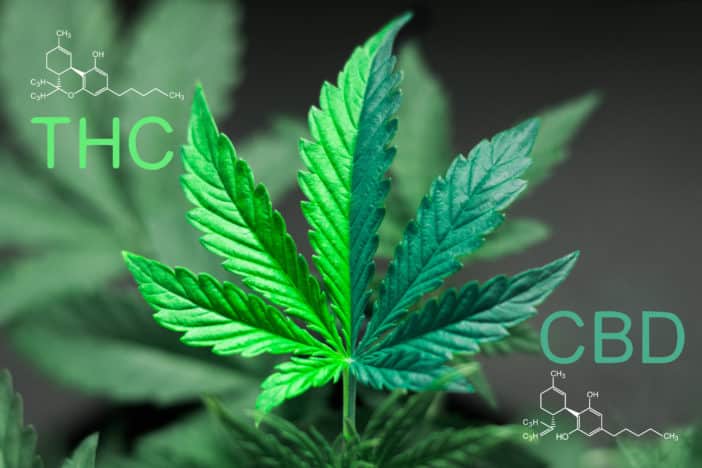Cannabidiol (CBD)

When one thinks of the hemp plant cannabis, various intoxicants usually spontaneously come to mind. And indeed, the drugs marijuana and hashish are produced from the dried flowers and leaves. However, the herbaceous plant, which is known for its strikingly palmate leaves, can do much more. In fact, it performs valuable services in many ways, as it contains more than 500 different ingredients. For example, the fibers of the stalks have been the basis for high-quality ropes for centuries, while the seeds are used to obtain edible oil. Hemp oil is one of the best edible oils of all, as it has an excellent fatty acid pattern. The edible oil (hemp seed oil) contains only small traces of cannabidiol (CBD), THC does not occur in it at all. Therefore, it can be purchased legally and without any problems.
The effectiveness of hemp as a medicine is still being intensively researched. Studies have already shown that medical cannabis can develop a medicinal potential in some types of cancer, but there is not yet sufficient evidence for this. In Germany, the plant with all its parts has been a prescription drug since 2017. Cannabis can thus be prescribed by a doctor, provided that the application is considered useful. Responsible for the medicinal effect of the hemp plant are the cannabinoids, first and foremost the tetrahydrocannabinol known under the abbreviation THC as well as cannabidiol (CBD). THC is a psychoactive substance, which means that it affects the human psyche and “befuddles”. Cannabidiol (CBD), on the other hand, is non-psychotropic, so it does not cause changes in consciousness and psyche.
What is Cannabidiol (CBD)?
It is believed that hemp was originally native to Central Asia. However, people have been spreading the crop for thousands of years. It is therefore now at home almost everywhere in the world, prefers a temperate to tropical climate and can reach different growth heights depending on the location. The cannabidiol contained exclusively in the female hemp is extracted from the leaves and flowers of the plant. The substance is present in the hemp plant mainly as an acid and is fat-soluble. The Israeli researcher and university lecturer Raphael Mechoulam was able to isolate the cannabinoid for the first time in 1963. He was also the first to succeed in synthesizing CBD, tetrahydrocannabinol and cannabigerol (another cannabinoid).
Cannabidiol (CBD) is an important component of Nabiximol, a hemp extract used medicinally for multiple sclerosis. In addition, cannabidiol (CBD) has been used to treat various epilepsy conditions since 2019 (Epidyolex). Basically, cannabidiol (CBD) is said to have anti-inflammatory, anticonvulsant, and anti-anxiety effects. It is also said to be able to suppress nausea and vomiting and relieve headaches. Unlike THC, cannabidiol (CBD) is no longer subject to narcotic regulations. The substance is not addictive and does not alter perception. The active ingredient is suitable for both internal and external use. That is why it is also increasingly being used in cosmetics.
Cannabidiol (CBD) in cosmetics
Cannabidiol (CBD) can already be found in many medical cosmetic products, mainly thanks to its anti-inflammatory effect. Whether acne, neurodermatitis or rosacea, inflammatory reactions are responsible for many skin diseases. These can be significantly alleviated by cannabidiol (CBD), which means that swelling and pain usually go down after a relatively short time and injuries heal faster. In contrast to preparations containing cortisone, which sooner or later inevitably lead to side effects, a product containing cannabidiol (CBD) can be used over a longer period without hesitation.
Dry skin also benefits from cannabidiol, as the active ingredient has a good moisturizing effect, but in principle CBD is aimed at every skin type. The antioxidants contained counteract the skin aging process and protect the cells. Cannabidiol is even able to boost the formation of new skin cells and reduce wrinkles.
Product ideas with cannabidiol (CBD)
The range of products containing CBD is therefore also growing. Creams, ointments, shower creams, tinctures, bath salts, shampoos and preparations for facial cleansing are already on the market. Athletes enjoy a relaxing massage with a CBD-containing balm or oil after competition or training. Men care for their beard with a cannabidiol beard oil that gently soothes stressed and irritated skin. A lip balm with cannabidiol (CBD) helps against dry and chapped lips. With most products, the transition from purely cosmetic use to medicinal effect is fluid. Cosmetics with cannabidiol (CBD) are usually made from specially selected hemp plant cultivars. Thus, a good quality and a high active ingredient content can be guaranteed. CBD products with an organic seal are particularly recommendable. However, cosmetics containing cannabidiol usually do not get by without carriers. Ideally, these should also be of natural origin. Tea tree oil, shea butter and hemp seed oil are particularly suitable, but other formulations are also conceivable. For consumers, the following rule of thumb can be helpful in the selection or purchase decision: The higher the CBD content in a cosmetic product, the stronger its effect.
Finally, the sustainable aspect should not remain unmentioned. Compared to cotton, the hemp plant requires significantly less water and is therefore one of the most sustainable crops in the world.
Natural CBD regulated as cosmetic ingredient by the EU
The Cosmetic Ingredient Database (CosIng), maintained by the European Commission’s “Directorate General for Internal Market, Industry, Entrepreneurship and SMEs (GROW),” has recently been expanded to include a new entry. Previously, only synthetically produced cannabidiol (CBD) was used in cosmetic products. That has now changed. Now manufacturers are also allowed to use pure natural cannabidiol (CBD) in their cosmetic preparations. Cosmetic companies within the EU very much welcome this step. Back in November of last year, the European Court of Justice stated in a ruling that cannabidiol should not be classified as a narcotic. The EIHA (European Industrial Hemp Association) then asked the Directorate General “GROW” to update the database for cosmetic ingredients. The previous prohibitions for Cannabis Sativa L. were lifted and new INCI entries were integrated. Cannabidiol (CBD) is now listed as a “derivative of an extract, tincture or resin of the cannabis plant.” So pure, naturally derived cannabidiol may be officially marketed within the EU for cosmetic products in the future. The same applies to CBD-containing extracts from leaves and flowers. However, the maximum THC content in the EU must not exceed a limit of 0.2 percent under any circumstances.
Fact Sheet Cannabidiol (CBD)
INCI: Cannabidiol
CAS number: 13956-29-1
Description: a non-psychotropic cannabinoid from the female hemp plant
Melting point: 66 to 67 degrees Celsius
Solubility: soluble in methanol, ethanol, benzene, diethyl ether, petroleum ether and chloroform, but practically insoluble in water
Molar mass: 314.46 g-mol-1
Action: anti-inflammatory, antispasmodic, analgesic, antianxiety, helps against nausea
Cosmetic indications: for inflammatory skin diseases such as rosacea and acne, for the care of dry and mature skin, and for maintaining the health of all other skin types
Possible uses: Skincare cream, balm, tincture, massage and beard oil, shampoo
We like to work with the raw materials containing cannabidiol:
| Trade Name | Company Name | INCI | Comment |
|---|---|---|---|
| Cannabidiol (CBD) Isolate Powder (910286) | Greentech | Cannabidiol | |
| CANNABIDIOL NATURAL ISOLATE 99% | DKSH | Cannabidiol | |
| Vita Pure CBD Synthetic | QUIMIVITA PRODUCTS SL | Cannabidiol | |
| Vita Pure CBD Natural | QUIMIVITA PRODUCTS SL | Cannabidiol | |
| SymDStress | Symrise | Cannabidiol | |
| BIKIRA Hempseed Oil with CBD | AE Chemie | Cannabis Sativa Seed Oil, Cannabidiol | |
| Lipobelle Pino C | Mibelle AG Biochemistry | Pinus Cembra Wood Extract, Cannabis Sativa Seed Oil, Cannabis Sativa Leaf Extract, Lecithin, Alcohol, Pentylene Glycol, Tocopherol, Water (Aqua) | |
| PhytoVec- CBD 5% | Rahn AG | Water, Phytol, Cannabidiol, Coco-Caprylate/Caprate, Polyglyceryl-10 Laurate, Lecithin | |
| CBD Oil Balance | Infinitec | Water (Aqua), Glycerin, Caprylic/Capric Triglyceride, Glyceryl Behenate, Cannabis Sativa Seed Oil, Lecithin, Theobroma Cacao (Cocoa) Seed Butter, Xanthan Gum, Cannabidiol, Benzyl Alcohol, Glyceryl Caprylate, Glyceryl Undecylenate |
High quality cosmetics with CBD from Cosmacon
While the intoxicating cannabinoid THC works in the head, so to speak, cannabidiol (CBD) unfolds its consistently positive effect in the body and skin. It does not fall under the Narcotics Act, so it can be used completely legally, is not addictive and is free of side effects. Another major advantage is the sustainable cultivation of the hemp plants. The active ingredient is therefore virtually predestined for sophisticated cosmetics and can help with inflammatory skin diseases, among other things. In a good quality cannabidiol costs about 2700 euros per kilogram: Cosmetics with CBD is therefore also considered the highest level of natural cosmetics. Feel free to ask us if you would like to use this legal trend ingredient in your cosmetics.
Sources:
Therapeutic Potential of Cannabidiol (CBD) for Skin Health and Disorders.; Clin Cosmet Investig Dermatol. 2020 Dec 8;13:927-942.
Cannabidiol Application Increases Cutaneous Aquaporin-3 and Exerts a Skin Moisturizing Effect.; Pharmaceuticals (Basel). 2021 Aug 30;14(9):879.
Cannabis sativa L. extract and cannabidiol inhibit in vitro mediators of skin inflammation and wound injury.; Phytother Res. 2019 Aug;33(8):2083-2093.
Cannabis sativa and Skin Health: Dissecting the Role of Phytocannabinoids.; Planta Med. 2022 Jun;88(7):492-506.
Pharmacology and legal status of cannabidiol.; Ann Ist Super Sanita. 2020 Jul-Sep;56(3):285-291.
